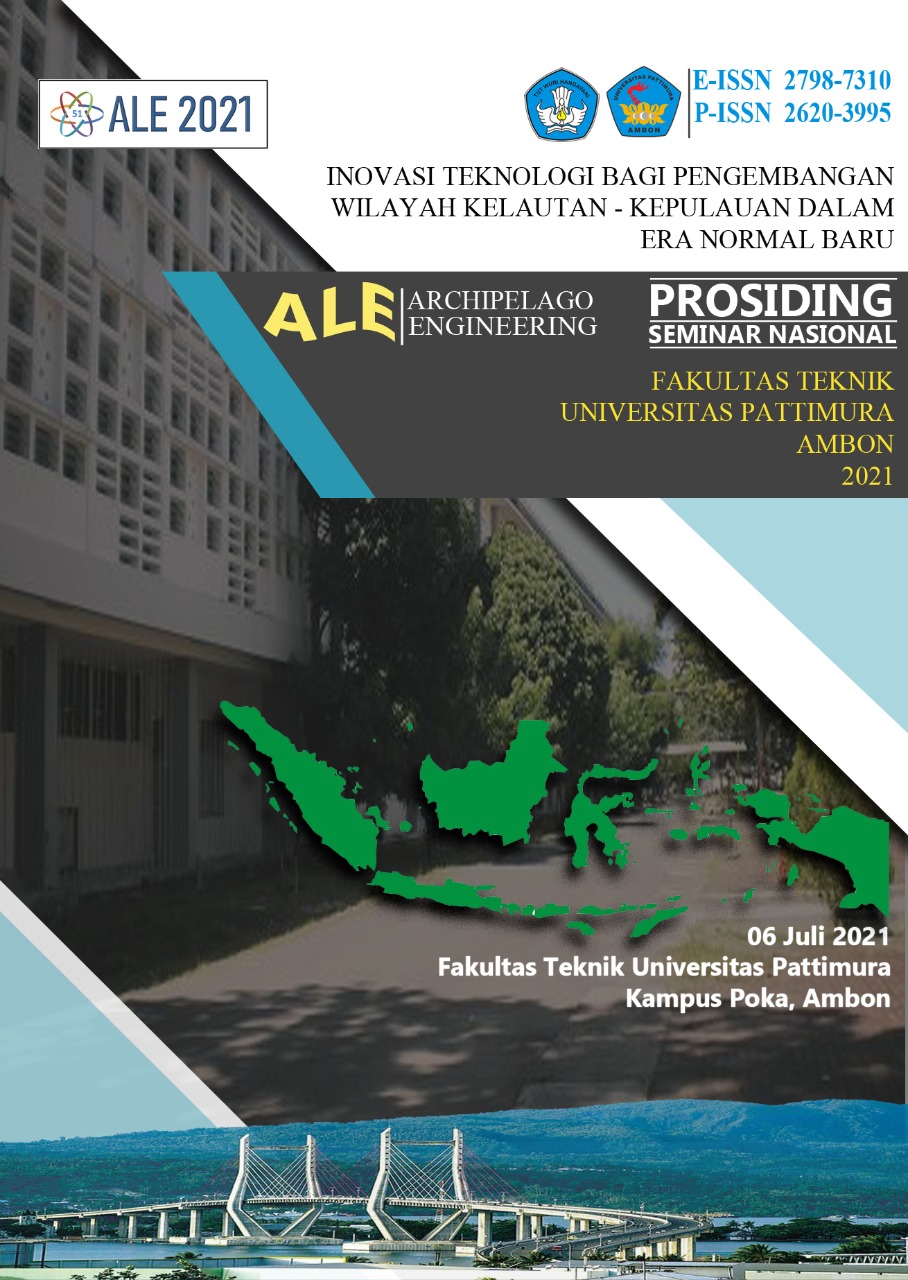ANALISIS LAJU ALIRAN MASSA FLUIDA DINGIN TERHADAP EFEKTIVITAS PENUKAR KALOR SHELL AND TUBE DESTILLASI MINYAK ATSIRI CENGKEH (Syzygium aromaticum)
Abstract
Shell and tube type heat exchanger is a component of clove essential oil distillation apparatus using hot steam as hot fluid and water as a cold fluid, each flowing in opposite directions. The distillation system in the field still uses a condenser or straight pipe heat exchanger, where the temperature of the hot fluid that comes out is still considered high enough so that the indication of effectiveness is not optimal. To optimize the effectiveness, a shell and tube heat exchanger is designed with a numerical method based on Fluent CFD using a hexagonal pipe geometry in tube layouts of 30°, 60°, 45°, and 90° inline and staggered arrangement and counter flow type. This study varied the cold mass flow rate (á¹c) = 0.052; 0.059; 0.083; 0.1; 0.12 Kg/s, while the mass flow rate of the hot fluid is constant. The simulation results obtained that the maximum effectiveness occurred at a mass flow rate of 0.052 kg/s of 5.45% staggered layout and the minimum occurred at a mass flow rate of 0.12 kg/s of 4.01% on an inline layout. The results of this research are also expected to help the community which can be used for various essential oils.
Downloads
References
[2] M. Dreger and K. Wielgus, “Application of essential oils as natural cosmetic preservatives,†vol. 59, no. 4, 2013, doi: 10.2478/hepo-2013-0030.
[3] A. Anita, S. Khotimah, and A. H. Yanti, “Aktivitas Antibakteri Ekstrak Daun Benalu Jambu Air (Dendropthoe pentandra (L.) Miq) Terhadap Pertumbuhan Salmonella typhi,†Protobiont, vol. 3, no. 2, pp. 268–272, 2014.
[4] J. Grush, D. L. . Noakes, and R. . Moccia, “The Efficacy of Clove Oil As An Anesthetic for the Zebrafish, Danio rerio (Hamilton),†vol. 1, no. 1, pp. 46–53, 2004.
[5] A. T. Lawang, D. Setyaningsih, and M. Syahbana, “Evaluasi Minyak Daun Cengkeh dan Minyak Sereh Wangi Sebagai Bioaditif Bahan Bakar Solar Dalam Menurunkan Emisis Gas Buang Pada Mesin Diesel,†Teknol. Pertan., vol. 20, no. 2, pp. 95–102, 2019.
[6] N. Nurdjannah, “Diversifikasi Penggunaan Cengkeh,†Perspektif, vol. 3, no. 2, pp. 61–70.
[7] R. K. Shah and D. P. Sekulic, Fundamentals of Penukar kalor Design. John Wiley & Sons, Inc, 2003.
[8] S. Chingulpitak and S. Wongwises, “A comparison of flow characteristics of refrigerants flowing through adiabatic straight and helical capillary tubes,†Int. Commun. Heat Mass Transf., vol. 38, no. 3, pp. 398–404, 2011, doi: 10.1016/j.icheatmasstransfer.2010.12.014.
[9] P. K. Sahoo, M. I. A. Ansari, and A. K. Datta, “A computer based iterative solution for accurate estimation of heat transfer coefficients in a helical tube penukar kalor,†J. Food Eng., vol. 58, no. 3, pp. 211–214, 2003, doi: 10.1016/S0260-8774(02)00370-9.
[10] W. H. Park and C. K. K. Yang, “Effects of using advanced cooling systems on the overall power consumption of processors,†IEEE Trans. Very Large Scale Integr. Syst., vol. 21, no. 9, pp. 1644–1654, 2013, doi: 10.1109/TVLSI.2012.2217386.
[11] H. Ma et al., “Assessment of the optimum operation conditions on a heat pipe penukar kalor for waste heat recovery in steel industry,†Renew. Sustain. Energy Rev., vol. 79, no. April, pp. 50–60, 2017, doi: 10.1016/j.rser.2017.04.122.
[12] K. Chen, Y. Chen, Y. She, M. Song, S. Wang, and L. Chen, “Construction of effective symmetrical air-cooled system for battery thermal management,†Appl. Therm. Eng., vol. 166, p. 114679, 2020, doi: 10.1016/j.applthermaleng.2019.114679.
[13] B. A. Bhanvase, S. D. Sayankar, A. Kapre, P. J. Fule, and S. H. Sonawane, “Experimental investigation on intensified convective heat transfer coefficient of water based PANI nanofluid in vertical helical coiled penukar kalor,†Appl. Therm. Eng., vol. 128, pp. 134–140, 2018, doi: 10.1016/j.applthermaleng.2017.09.009.
[14] S. M. Hashemi and M. A. Akhavan-Behabadi, “An empirical study on heat transfer and pressure drop characteristics of CuO-base oil nanofluid flow in a horizontal helically coiled tube under constant heat flux,†Int. Commun. Heat Mass Transf., vol. 39, no. 1, pp. 144–151, 2012, doi: 10.1016/j.icheatmasstransfer.2011.09.002.
[15] N. Ghorbani, H. Taherian, M. Gorji, and H. Mirgolbabaei, “Experimental study of mixed convection heat transfer in vertical helically coiled tube penukar kalors,†Exp. Therm. Fluid Sci., vol. 34, no. 7, pp. 900–905, 2010, doi: 10.1016/j.expthermflusci.2010.02.004.
[16] M. Majid Etghani and S. Amir Hosseini Baboli, “Numerical investigation and optimization of heat transfer and exergy loss in shell and helical tube penukar kalor,†Appl. Therm. Eng., vol. 121, pp. 294–301, 2017, doi: 10.1016/j.applthermaleng.2017.04.074.
[17] Jayanudin, “Komposisi kimia minyak atsiri daun cengkeh dari proses penyulingan uap,†Tek. Kim. Indones., vol. 10, no. 1, pp. 37–42, 2011.
[18] C. Wijaya, A. Jayuska, and A. H. Alimuddin, “Peningkatan Rendemen Minyak Atsiri Daun Cengkeh (Syzygium aromaticum) Dengan Metode Delignifikasi dan Fermentasi,†vol. 4, no. 4, pp. 15–20, 2015.
[19] R. Waelauruw, Analisis Laju Kondensasi Akibat Pengaruh Beban Panas dan Massa Gagang Cengkeh Terhadap Karakteristik Perpindahan Panas Pada Destilasi Minyak Atsiri. Fakultas Teknik Universitas Pattimura, 2016.
[20] N. Titahelu, Analisis Pengaruh Masukan Panas Terhadap Karakteristik Proses Destilasi Minyak Atsiri Cengkeh (Syzygium aromaticum), April. 2019.
[21] A. P. Shinde, M. L. Shinde, S. S. Yadav, M. R. Surve, A. S. Futane, M. Bhaumik, “Performance Analysis of Penukar kalor using CFD“, International Journal of Innovative Research in Science engineering and Techonogy., vol 7(3), pp: 3053-3063, 2018, doi: 10.15680/IJIRSET.2018.0703072.
[22] Sobar Ihsan, 2017. Perencanaan dan analisa perhitungan jumlah tube dan diameter shell pada kondensor berpendinginan air pada sistem refrigerasi NH3, Jurnal Teknologi Proses dan Inovasi Industri, Vol. 2 (1), pp:13-17, 2017.
[23] S. Kallannavar, S. Mashyal, M. Rajangale, Effect of tube layout on the performance of shell and tube penukar kalors, Material Today: Proceedings, PP:1-5, 2019, doi:10.1016/j.matpr.2019.10.151
[24] Avinash P. Shinde, Mahadev L. Shinde, Sagar S. Yadav, Manasvi R. Surve, A. S. Futune, Mainak Bhaumik., 2018. “Perfomance Analysis of Penukar kalor using CFDâ€, Mechanical Enginering, Navi Mumbai, India.
Copyright (c) 2021 Rengga Said, Nicolas Titahelu, Rikhard S. Ufie

This work is licensed under a Creative Commons Attribution-ShareAlike 4.0 International License.
An author who publishes in the ALE Proceeding agrees to the following terms:
- Author retains the copyright and grants ALE Proceeding the right of first publication of the work simultaneously licensed under the Creative Commons Attribution-ShareAlike 4.0 License that allows others to share the work with an acknowledgment of the work's authorship and initial publication in this journal.
- Author is able to enter into separate, additional contractual arrangements for the non-exclusive distribution of the journal's published version of the work (e.g., post it to an institutional repository or publish it in a book) with the acknowledgment of its initial publication in this journal.
- Author is permitted and encouraged to post his/her work online (e.g., in institutional repositories or on their website) prior to and during the submission process, as it can lead to productive exchanges, as well as earlier and greater citation of the published work (See The Effect of Open Access).
Read more about the Creative Commons Attribution-ShareAlike 4.0 Licence here: https://creativecommons.org/licenses/by-sa/4.0/.






